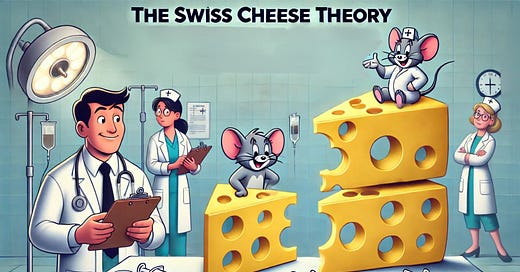The Swiss Cheese Theory: Why Errors Love Holes (And How to Fix Them)
How the Swiss Cheese Model Explains Medical Errors and Teaches Us to Be Safer
Remember those classic Tom and Jerry cartoons? Tom would set a trap for Jerry with a block of Swiss cheese—full of big, tempting holes. Jerry always seemed to navigate those holes with ease, outsmarting Tom every time. Now, imagine those cheese holes not as a path for a clever mouse but as opportunities for errors to sneak through.
This is the essence of the Swiss Cheese Theory of Errors, introduced by psychologist James Reason. The theory explains why mistakes occur, especially in complex systems like healthcare. Think of each slice of cheese as a defense mechanism—policies, training, technology—that should block errors. But if the holes align, disaster sneaks through, just like Jerry dodging Tom’s traps.
Let’s take a slice-by-slice tour of this cheesy analogy. Don’t worry—no stethoscope is required, just a sense of humor and a love for making things better!
Slice 1: Humans Are... Well, Human
People make mistakes. It’s as universal as sneezing when you sniff pepper. In the medical field, think of a junior doctor calculating and prescribing “Potassium 40 mg” instead of “Potassium 40 mEq.” It’s not malicious; it’s a slip, a hole in the cheese.
But wait—before you start blaming the doc, remember this: the system should catch such errors. That’s where other cheese slices come in.
Slice 2: Policies and Protocols (The Boring Yet Vital Layer)
Hospitals have policies for almost everything. Think of them as the recipe book for safe patient care. But if these protocols are outdated or unclear, they create their own holes. Then there are policies and protocols that look perfect on paper but never make it to practice. They are like having an umbrella with holes—it looks good, but you’re still going to get drenched!
Imagine this scenario: A nurse reads the potassium prescription but doesn’t double-check the dosage because the hospital hasn’t enforced a “read-back” protocol. Or, if a nurse isn’t empowered by protocol to question a prescription, it’s like spotting a crack in the dam but being told to just let the water flow—another hole in the system, waiting for trouble to gush through!
Slice 3: Technology (A Double-Edged Scalpel)
Ah, technology—our trusty (and sometimes not-so-trusty) assistant. Electronic Health Records (EHR) can flag unusual dosages, but only if programmed correctly. If the software is glitchy or the alert fatigue is high (because it pings for every minor thing), another hole forms.
For instance, if the EHR doesn’t recognize “mg” as a red flag for potassium, it’s like a hole in your cheese that got widened with a drill.
Slice 4: Environment and Fatigue (Because We're Not Robots)
Healthcare professionals are superheroes, but even superheroes need sleep and coffee breaks. Imagine a nurse on her 14th hour of a shift trying to decipher chicken-scratch handwriting. Add the pressure of an overcrowded ward, and you’ve got the perfect storm for errors.
The chaotic environment creates a giant crater in the cheese. Combine that with all the previous holes, and you’re on the fast track to an incident report.
When the Holes Align: A Medical Mishap
Here’s how it all comes together—or rather, falls apart.
Let’s revisit our potassium prescription. The doctor makes a mistake (Slice 1). The protocol doesn’t mandate a double-check (Slice 2). The EHR fails to flag the error (Slice 3). The nurse, exhausted, administers the incorrect dose (Slice 4).
Voila! The holes have aligned, and the patient ends up with a dangerously high potassium level. Cue alarms, adrenaline, and a swift recovery effort.
Plugging the Holes: Making Swiss Cheese Into Cheddar
The good news? The Swiss Cheese Model isn’t about pointing fingers; it’s about plugging holes. Here’s how:
Train Your People
Educate healthcare workers about common errors and how to avoid them. Simulation training for high-risk scenarios can save lives—and maybe even win awards for best dramatic performance.Revamp Protocols
Make sure policies are clear, up-to-date, and user-friendly. Nobody should need a law degree to interpret hospital guidelines. And communicate them down the line.Foster a safety culture
Encourage nurses to speak up when they notice an error. Empower them to voice concerns without hesitation, ensuring patient safety.
Use Technology Wisely
Invest in systems that are intuitive and customizable. And yes, give tech a break with fewer, but more meaningful alerts.Take Care of the Caregivers
Working 14-hour shifts without adequate breaks is unsustainable. Foster a culture that values well-being—because exhausted individuals make poor decisions.A Final Slice of Wisdom
The Swiss Cheese Model is a reminder that mistakes are rarely the fault of one person. They’re a team sport—and not the fun kind. But by understanding the layers of defense, we can ensure the holes rarely align.
After all, in healthcare, we’re not trying to catch a mouse—we’re saving lives. Let’s make sure the holes don’t align. And if they do, let’s learn from it to ensure the next block of cheese is a little less hole-y and a lot more wholesome!
P.S. Would love to hear your thoughts! Have you encountered situations where the Swiss Cheese Theory played out in your healthcare setting? Share your experiences in the comments below! Let’s learn from each other and work towards safer, more efficient healthcare environments.




